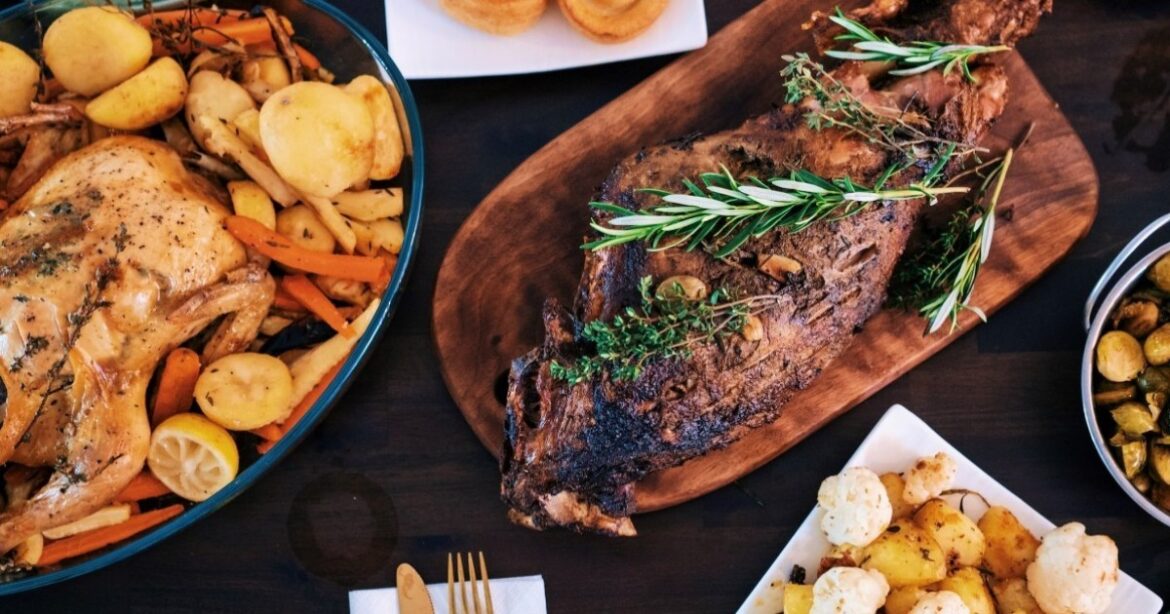Christmas in Portugal runs from the Consoada supper on 24th December through family lunches to Twelfth Night. Portuguese Christmas food shifts by region, with fish‑first evenings in some homes, hearty roasts inland and decadent sweets in the south.
Wherever you choose to spend Christmas in Portugal, expect a general and wide array of festive treats on the table and at Christmas markets.
Savoury Christmas dishes in Portugal
Bacalhau da Consoada (Christmas Eve)
Boiled salt cod with potatoes, cabbage, carrots and eggs, finished with warm olive oil and sometimes garlic. It’s rooted in older abstinence customs and reveals one of the many ways that the Portuguese consume cod.
Polvo à lagareiro (north)
Roast octopus with smashed potatoes, garlic and olive oil. The name nods to olive‑press workers, so both the octopus and the potatoes are drenched in good olive oil.
Roupa velha de bacalhau (Christmas Day)
A popular Portuguese Christmas tradition that gives Boxing Day energy but on the 25th. The name means “old clothes” and is a thrifty festive tradition. Shred the cod and veg from Consoada, toss with onions and eggs, and fry until golden at the edges.
Cabrito assado no forno
Oven‑roasted kid goat with potatoes and rice, deeply seasoned and slow‑cooked. It’s typically marinated with garlic, bay leaf and white wine, then roasted in a clay tray.
Peru recheado
Stuffed roast turkey for bigger gatherings, with recipes ranging from chestnut‑and‑sausage to herb‑and‑veg mixes.
Leitão (Bairrada and Beiras)
Roast suckling pig sometimes takes centre stage, especially for New Year tables. In Bairrada, it’s cooked in wood ovens and served with orange slices and a garlicky, peppery gravy.
Caldo verde (starter)
The soothing kale‑and‑potato soup that often opens a home menu, with or without chouriço. It’s traditionally ladled into earthenware bowls and eaten with slices of corn bread.
Portuguese Christmas sweets and baked goods
Rabanadas and fatias douradas
Bread slices soaked in milk or wine syrup, dipped in egg, fried and dusted with cinnamon sugar. Many families use day‑old bread or cacete to soak up more custard.
Filhós and sonhos
Yeasted or choux‑style fritters fried and rolled in cinnamon sugar. Shapes and names shift by district, but the ritual of frying after Midnight Mass is shared.
Aletria
A sweet vermicelli pudding scented with lemon and cinnamon, especially beloved in the north. The top is often finished with cinnamon patterns or a hand‑written “Feliz Natal”.
Arroz doce
Silky rice pudding with lemon peel and a neat cinnamon lattice on top, found across the country. It’s traditionally made with arroz carolino and whole milk for that creamy texture.
Lampreia de ovos
Convent‑sweet indulgence and one of Portugal’s most popular desserts. This creation is an almond‑yolk paste shaped like a lamprey, typically found in Aveiro.
Broas castelares and broas de mel
Soft chestnut or honey biscuits, tied to the centre and Alentejo. The chestnut version is dense and tender, while the honey ones are scented with olive oil and warm spices.
Bolo Rei and Bolo Rainha
Crown‑shaped enriched dough scented with citrus, studded with nuts and dried fruit. A dry bean is often hidden inside, and the finder of the bean traditionally buys the next cake.
Portuguese festive drinks
Porto, Moscatel and espumante
Tawny or ruby Port with puddings, Moscatel de Setúbal for nutty sweets, and Portuguese sparkling espumante from Bairrada or Távora‑Varosa for toasts.
A little nip
Ginjinha appears after lunch in many homes, alongside walnut liqueurs and aged aguardente.
—————–
Stay in the know about living in Portugal as a foreigner—get our weekly newsletter for the latest travel, legal, and lifestyle news.


Dining and Cooking